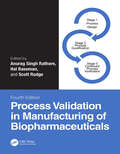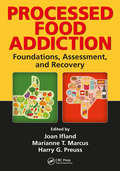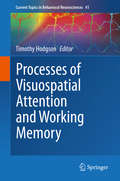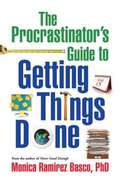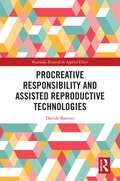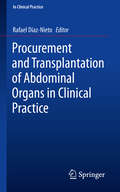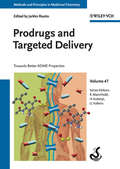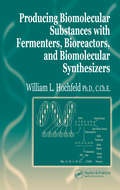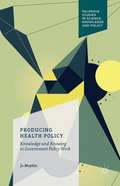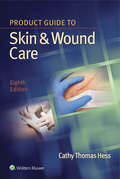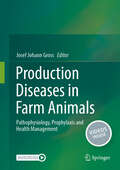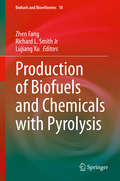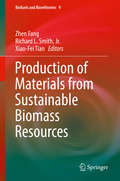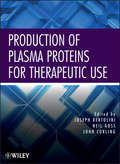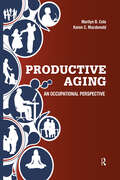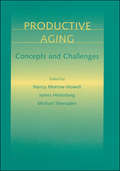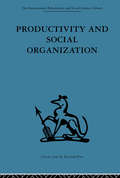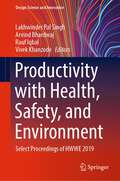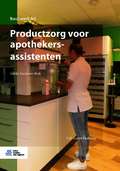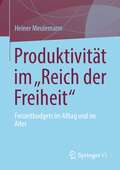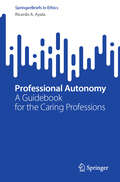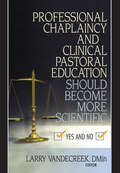- Table View
- List View
Process Validation in Manufacturing of Biopharmaceuticals (Biotechnology and Bioprocessing)
by Hal Baseman Scott Rudge Anurag Singh RathoreThe fourth edition of Process Validation in Manufacturing of Biopharmaceuticals is a practical and comprehensive resource illustrating the different approaches for successful validation of biopharmaceutical processes. A pivotal text in its field, this new edition provides guidelines and current practices, contains industrial case studies, and is expanded to include in-depth analysis of the new Process Validation (PV) guidance from the US FDA. Key Features: Offers readers a thorough understanding of the key concepts that form the basis of a good process validation program for biopharmaceuticals. Includes case studies from the various industry leaders that demonstrate application of these concepts. Discusses the use of modern tools such as multivariate analysis for facilitating a process validation exercise. Covers process characterization techniques for scaling down unit operations in biopharmaceutical manufacturing, including chromatography, chemical modification reactions, ultrafiltration, and microfiltration, and practical methods to test raw materials and in-process samples. Providing a thorough understanding of the key concepts that form the basis of a good process validation program, this book will help readers ensure that PV is carried out and exceeds expectations. Fully illustrated, this is a much-needed practical guide for biopharmaceutical manufacturers.
Processed Food Addiction: Foundations, Assessment, and Recovery
by Harry G. Preuss Joan Ifland Marianne T. MarcusObesity and eating disorders have stubbornly refused to respond to treatment since the 1990’s. This book organizes the evidence for a possible answer, i.e., that the problem could be one of addiction to processed foods. In a Processed Food Addiction (PFA) model, concepts of abstinence, cue-avoidance, acceptance of lapses, and consequences all play a role in long-term recovery. Application of these concepts could provide new tools to health professionals and significantly improve outcomes. This book describes PFA recovery concepts in detail. The material bridges the research into practical steps that health professionals can employ in their practices. It contains an evidence-based chapter on concepts of abstinence from processed foods. It rigorously describes PFA pathology according to the DSM 5 Addiction Diagnostic Criteria. It applies the Addiction Severity Index to PFA so that health practitioners can orient themselves to diagnosing and assessing PFA. It contains ground-breaking insight into how to approach PFA in children. Because the book is evidence-based, practitioners can gain the confidence to put the controversy about food addiction to rest. Practitioners can begin to identify and effectively help their clients who are addicted to processed foods. This is a breakthrough volume in a field that could benefit from new approaches.
Processes of Visuospatial Attention and Working Memory (Current Topics in Behavioral Neurosciences #41)
by Timothy HodgsonThis volume covers a broad range of current research topics addressing the function of visuospatial attention and working memory. It discusses a variety of perspectives ranging from evolutionary and genetic underpinnings to neural substrates/computational processes and the connection between attention and working memory. Contributions address the topic at the molecular, system and evolutionary scales and will be of interest to a range of audiences from animal behaviour specialists, experimental psychologists to clinicians in the field of psychiatry and neurology.
Processing of Hyperspectral Medical Images
by Robert KoprowskiThis book presents new methods of analyzing and processing hyperspectral medical images, which can be used in diagnostics, for example for dermatological images. The algorithms proposed are fully automatic and the results obtained are fully reproducible. Their operation was tested on a set of several thousands of hyperspectral images and they were implemented in Matlab. The presented source code can be used without licensing restrictions. This is a valuable resource for computer scientists, bioengineers, doctoral students, and dermatologists interested in contemporary analysis methods.
Procrastinator's Guide to Getting Things Done
by Robert Leahy Monica BascoEveryone waits till the last minute sometimes. But many procrastinators pay a significant price, from poor job performance to stress, financial problems, and relationship conflicts. Fortunately, just as anyone can endlessly delay, anyone can learn how to stop! Cognitive-behavioral therapy expert Monica Ramirez Basco shows exactly how in this motivating guide. Dr. Basco peppers the book with easy-to-relate-to examples from "recovering procrastinators"--including herself. Inviting quizzes, exercises, and practical suggestions help you Understand why you procrastinate. Start with small changes that lead to big improvements. Outsmart your own delaying tactics. Counteract self-doubt and perfectionism. Build crucial skills for getting things done today.
Procreative Responsibility and Assisted Reproductive Technologies (Routledge Research in Applied Ethics)
by Davide BattistiThis book rethinks procreative responsibility considering the continuous development of Assisted Reproductive Technologies. It presents a person-affecting moral argument, highlighting that the potential availability of future Assisted Reproductive Technologies brings out new procreative obligations.Traditionally, Assisted Reproductive Technologies are understood as practices aimed at extending the procreative freedom of prospective parents. However, some scholars argue that they also give rise to new moral constraints. This book builds on this viewpoint by presenting a person-affecting perspective on the impact of current and future Assisted Reproductive Technologies on procreative responsibility, with a specific focus on reproductive Genome Editing and ectogenesis. The author shows that this perspective is defensible both from a consequences-based person-affecting perspective and from a person-affecting account that considers morally relevant intuitions and attitudes.Procreative Responsibility and Assisted Reproductive Technologies will appeal to scholars and advanced students working in bioethics and procreative ethics.
Procurement and Transplantation of Abdominal Organs in Clinical Practice (In Clinical Practice)
by Rafael Díaz-NietoThis practical guide provides a full but concise account of the organ donation and transplantation process, from the management of the donor and organ preservation to perioperative management and surgical techniques.Readers will learn about various aspects of multi-organ retrieval such as different types of donors and evaluation of organ donors, as well as the retrieval process itself and ethical aspects of transplantation. Written in a consistent format, each of the themed parts examines the different types of solid organ transplantation, namely kindey, pancreas and liver. Each part discusses the indications for transplantation, organ allocation, surgical technique, post-operative management outcomes and professional skills for the surgeon. This is an essential guide for the transplant surgeon offering a unique summary of the critical issues in abdominal organ transplantation.
Prodrugs and Targeted Delivery: Towards Better ADME Properties (Methods and Principles in Medicinal Chemistry #47)
by Raimund Mannhold Gerd Folkers Hugo KubinyiThis topical reference and handbook addresses the chemistry, pharmacology, toxicology and the patentability of prodrugs, perfectly mirroring the integrated approach prevalent in today's drug design. It summarizes current experiences and strategies for the rational design of prodrugs, beginning at the early stages of the development process, as well as discussing organ- and site-selective prodrugs. Every company employing medicinal chemists will be interested in this practice-oriented overview of a key strategy in modern drug discovery and development.
Producing Biomolecular Substances with Fermenters, Bioreactors, and Biomolecular Synthesizers
by William L. HochfeldContaining authoritative and in-depth coverage, Producing Biomolecular Materials Using Fermenters, Bioreactors, and Biomolecular Synthesizers examines the bioproduction systems that support the controlled, automated, and quantity growth of proteins. The book discusses the substance, character, makeup, and quality of the basic materials used
Producing Health Policy
by Jo MaybinIn this book Jo Maybin draws on rare access to the inner-workings of England's Department of Health to explore what kinds of knowledge civil servants use when developing policy, how they use it and why. Combining ethnographic data with insights from psychology, socio-linguistics, sociology and philosophy, she demonstrates how civil servants engage in a wide range of knowledge practices in the course of their daily work. These include sharing personal anecdotes, thrashing-out ideas in meetings and creating simplified representations of phenomena, as well as conducting cost-benefit analyses and commissioning academic research. Maybin analyzes the different functions that these various practices serve, from developing personal understandings of issues, to making complex social problems 'thinkable', and meeting the ever-present need to make policies 'happen'. In doing so, she develops an original theory of policy-making as the work of building connections between a policy in development and powerful ideas, people, and instruments, and reveals the 'policy know-how' required by civil servants to be effective in their jobs.
Product Guide to Skin & Wound Care
by Cathy HessChoose the best possible skin and wound care products to support your patients’ skin health and wound healing, with the invaluable Product Guide to Skin and Wound Care, 8th Edition. Listing 294 products in alphabetical order, this handy product guide for wound care practitioners across all practice settings offers detailed information—sizes, action, indications, contraindications, application, and removal information—so that your choices stay informed and accurate.
Production Diseases in Farm Animals: Pathophysiology, Prophylaxis and Health Management
by Josef Johann GrossThis textbook deals comprehensively with livestock production diseases and their prevention in the major species: ruminants, swine, and poultry. It gives an interdisciplinary view on pathophysiology, prophylaxis, and health management.Livestock breeding and husbandry is often accompanied by a conflict of interest between the animal´s biological requirements and economic producer needs. This conflict is increasingly gaining attention not only by producers, animal scientists, and veterinarians, but also by the public. It creates significant future challenges, which are described and addressed in this book. The main topics covered are: • the use of antimicrobials with emphasis on security and safety for producers/consumers• the impact of locomotion disorders on performance and welfare of farm animals • the interactions of gut microbiome, genetics, climate change, metabolic status and mineral homeostasis with reproduction, performance, animal health and welfare• infectious and respiratory diseases• the raising of neonatesA special section is devoted to behavioural signs indicating an impaired animal welfare. These are the basis for precision livestock farming (PLF) technology and the development of new management concepts. The present work is a valuable resource for veterinarians, students, as well as expert readers from animal and agricultural sciences, food safety and technology. Supplementary videos can be accessed online as well as directly from the print book; simply download the Springer Nature More Media App for free and scan the links with the play button.
Production of Biofuels and Chemicals with Pyrolysis (Biofuels and Biorefineries #10)
by Richard L. Smith Zhen Fang Lujiang XuThis book presents a collection of studies on state-of-art techniques for converting biomass to chemical products by means of pyrolysis, which are widely applicable to the valorization of biomass. In addition to discussing the fundamentals and mechanisms for producing bio-oils, chemicals, gases and biochar using pyrolysis, it outlines key reaction parameters and reactor configurations for various types of biomass. Written by leading experts and providing a broad range of perspectives on cutting-edge applications, the book is a comprehensive reference guide for academic researchers and industrial engineers in the fields of natural renewable materials, biorefinery of lignocellulose, biofuels, and environmental engineering, and a valuable resource for university students in the fields of chemical engineering, material science and environmental engineering.
Production of Materials from Sustainable Biomass Resources (Biofuels and Biorefineries #9)
by Zhen Fang Richard L. Smith Jr Xiao-Fei TianThis book presents a collection of studies on state-of-art techniques developed specifically for lignocellulose component derivation, and for the production of functional materials, composite polymers, carbonaceous biocatalysts, and pellets from lignocellulosic biomass, with an emphasis on using sustainable chemistry and engineering to develop innovative materials and fuels for practical application. Technological strategies for the physical processing or biological conversion of biomass for material production are also presented. All chapters were contributed by respected experts in the field from around the globe, providing a broad range of perspectives on cutting-edge applications.The book offers an ideal reference guide for academic researchers and industrial engineers in the fields of natural renewable materials, biorefinery of lignocellulose, biofuels and environmental engineering. It can also be used as a comprehensive reference source for university students in chemical engineering, material science and environmental engineering.
Production of Plasma Proteins for Therapeutic Use
by Neil Goss John Curling Joseph BertoliniSets forth the state of the science and technology in plasma protein production With contributions from an international team of eighty leading experts and pioneers in the field, Production of Plasma Proteins for Therapeutic Use presents a comprehensive overview of the current state of knowledge about the function, use, and production of blood plasma proteins. In addition to details of the operational requirements for the production of plasma derivatives, the book describes the biology, development, research, manufacture, and clinical indications of essentially all plasma proteins with established clinical use or therapeutic potential. Production of Plasma Proteins for Therapeutic Use covers the key aspects of the plasma fractionation industry in five sections: Section 1: Introduction to Plasma Fractionation initially describes the history of transfusion and then covers the emergence of plasma collection and fractionation from its earliest days to the present time, with the commercial and not-for-profit sectors developing into a multi-billion dollar industry. Section 2: Plasma Proteins for Therapeutic Use contains 24 chapters dedicated to specific plasma proteins, including coagulation factors, albumin, immunoglobulin, and a comprehensive range of other plasma-derived proteins with therapeutic indications. Each chapter discusses the physiology, biochemistry, mechanism of action, and manufacture of each plasma protein including viral safety issues and clinical uses. Section 3: Pathogen Safety of Plasma Products examines issues and procedures for enhancing viral safety and reducing the risk of transmissible spongiform encephalopathy transmission. Section 4: The Pharmaceutical Environment Applied to Plasma Fractionation details the requirements and activities associated with plasma collection, quality assurance, compliance with regulatory requirements, provision of medical affairs support, and the manufacture of plasma products. Section 5: The Market for Plasma Products and the Economics of Fractionation reviews the commercial environment and economics of the plasma fractionation industry including future trends, highlighting regions such as Asia, which have the potential to exert a major influence on the plasma fractionation industry in the twenty-first century.
Productive Aging: An Occupational Perspective
by Marilyn B. Cole Karen Crane MacdonaldProductive Aging: An Occupational Perspective is a concise and practical text that takes a fresh look at our rapidly expanding and diverse older population. Recognizing the unique identity of each older person, this text provides client-centered guidelines for maximizing function, independence, and wellness. Productive Aging also outlines self-management strategies for promoting participation and engagement in productive occupations for the older persons’ own continuing development, health, and well-being.Productive Aging not only summarizes current evidence, but it looks into the lives of forty productive agers who shared their personal perspective with the authors as part of an original qualitative study. These participant stories, often told in the participants own words, describe how current theories of aging are applied in the lives of older adults who are currently living the experience. Older adults ages 60 to 98 describe the effective strategies they used to manage their own aging process, to structure healthy lifestyles and social connections, and to intentionally direct their own productive occupations in satisfying and meaningful ways. The results of this qualitative research study have led to a grounded theory of Conditional Independence, which guides occupational therapy approaches to productive aging in practice. Authors Marilyn B. Cole and Dr. Karen C. Macdonald explore the six productive occupations that researchers have identified as typical of older adults today: self-management, home management, volunteering, paid work, care giving, and lifelong learning. In addition to summarizing current research and theories within each occupation, concrete strategies and techniques relative to these roles are detailed, with multiple examples, case studies, and learning activities. Throughout Productive Aging, interviews with experienced practitioners, administrators, and educators reveal some of the implications of various trends and techniques. For occupational therapists, descriptions of settings and types of intervention are consistent with the latest version of AOTA’s Occupational Therapy Practice Framework, Third Edition. In addition to promoting productive occupations within traditional institutional and medical-based practice, occupational therapy roles include that of consultant, educator, and advocate when treating individuals, groups, and populations in home care, organizational, and community settings. Special attention is given to developing the ability to become an effective self-manager, facilitating social participation, and maximizing clients’ applied functional abilities.Productive Aging: An Occupational Perspective is the perfect addition to the bookshelf of occupational therapy students, faculty, and clinicians, as well as any health care practitioner who would like to update his or her knowledge of the aging individual within his or her current practice settings.
Productive Aging: Concepts and Challenges (Gerontology)
by Michael Sherraden Nancy Morrow-Howell James Hinterlong"Will 69 million baby boomers suddenly drop out of the workforce when they turn 65? It is difficult to imagine this generation, with its talent, education, and experience, idling away the last thirty years of life."—From the Foreword, by Robert N. Butler, M.D., The Mount Sinai Medical CenterOld age has been historically thought of as a period of frailty and dependence, yet studies show that with the help of advances in health and medicine, current populations will live longer and remain healthier than previous generations. As average life expectancies rise, traditional concepts of retirement need to be reconsidered on all levels—from government policy to business practice to individual life planning. In this volume, leaders in the field of gerontology explore these changing conditions through the concept of "productive aging," which has been developed by leaders in the field to promote older adults' contributions to society in social and economic capacities.Productive Aging: Concepts and Challenges treats the implications of productive aging for the discipline of gerontology and for society in general. The first section defines the principles, historical perspectives, and conceptual frameworks for productive aging. The second section takes a disciplinary approach, treating the biomedical, psychological, sociological, and economic implications of a more capable older generation. The third section considers advances in theories of gerontology, and the fourth section suggests future directions in practice, theory, and research. Contributors: W. Andrew Achenbaum, University of Houston • Scott A. Bass, University of Maryland-Baltimore • Vern L. Bengtson, University of Southern California • James E. Birren, UCLA • Francis G. Caro, University of Massachusetts Boston • Carroll L. Estes, University of California-San Francisco • Marc Freedman, Civic Ventures (co-founder of Experience Corps) • James Hinterlong, Washington University • James S. Jackson, University of Michigan • Jane L. Mahakian, Pacific Senior Services • Harry R. Moody, Robert Wood Johnson Foundation • Nancy Morrow-Howell, Washington University • Philip Rozario, Washington University • James H. Schulz, Brandeis University • Michael Sherraden, Washington University • Alvar Svanborg, University of Illinois-Chicago and Goteburg University, Sweden • Brent A. Taylor, San Diego State University
Productivity and Social Organization: The Ahmedabad experiment: technical innovation, work organization and management
by A. K. RiceTavistock Press was established as a co-operative venture between the Tavistock Institute and Routledge & Kegan Paul (RKP) in the 1950s to produce a series of major contributions across the social sciences. This volume is part of a 2001 reissue of a selection of those important works which have since gone out of print, or are difficult to locate. Published by Routledge, 112 volumes in total are being brought together under the name The International Behavioural and Social Sciences Library: Classics from the Tavistock Press. Reproduced here in facsimile, this volume was originally published in 1958 and is available individually. The collection is also available in a number of themed mini-sets of between 5 and 13 volumes, or as a complete collection.
Productivity with Health, Safety, and Environment: Select Proceedings of HWWE 2019 (Design Science and Innovation)
by Rauf Iqbal Vivek Khanzode Arvind Bhardwaj Lakhwinder Pal SinghThis volume comprises select proceedings of the International Conference on Humanizing Work and Work Environment organized by the Indian Society of Ergonomics (HWWE2019). The book presents research findings on different areas of ergonomics for developing appropriate tools and work environment considering capabilities and limitations of working people for maximum effectiveness on their performance. This volume will be of interest to academics, professionals and practitioners in the field of ergonomics.
Productzorg voor apothekersassistenten (Basiswerk AG)
by Y.M. Groot-PadbergDit boek gaat over het beschikbaar stellen van geneesmiddelen en zelfzorgmiddelen, voorraadbeheer en logistiek. Daarbij houdt de apothekersassistent rekening met de behoeften van de patiënt, de houdbaarheid en de leveringstijd van middelen. Met theoretische kennis over het bereiden van verschillende toedieningsvormen gaat de apothekersassistent na of het geneesmiddel kan worden klaargemaakt of bereid. De apothekersassistent past daarbij richtlijnen, protocollen en vaststaande procedures toe.Dit boek sluit naadloos aan op kerntaak 3 (Biedt productzorg) van het Kwalificatiedossier mbo Apothekersassistent. Met dit boek krijgen studenten theoretische basiskennis over verschillende toedieningsvormen, zodat zij zelfstandig producten kunnen afleveren en correcte productinformatie kunnen geven. Verdiepende kennis over het bereiden van geneesmiddelen is ondergebracht in Bereiden en aseptisch handelen (1e druk), een nieuw boek in de reeks Basiswerk AG.Productzorg voor apothekersassistenten (5e druk) is onmisbaar als basisboek voor de opleiding tot apothekersassistent. Ook kan het boek uitstekend als naslagwerk in de praktijk worden gebruikt.Yvonne Groot-Padberg studeerde farmacie in Amsterdam. Na het behalen van het apothekersdiploma in 1988 is zij werkzaam geweest in de farmaceutische industrie als productontwikkelaar en farmaceutisch projectleider. Sinds 2002 is zij werkzaam in het mbo-onderwijs, waar zij naast haar werk als teamleider lessen in productzorg verzorgt.
Produktivität im „Reich der Freiheit“: Freizeitbudgets im Alltag und im Alter
by Heiner MeulemannGewinnen mit der wachsenden Freizeit produktive auf Kosten konsumtiver Aktivitäten? Zeitbudgetbefragungen zeigen, wie sich mit der wachsenden Freizeit die Verteilung der Freizeit auf produktive und konsumtive Aktivitäten verändert – sowohl in der täglichen Freizeit aller wie mit dem Freizeitgewinn durch Alter und Ruhestand. Im Zeitbudget der gesamten deutschen Bevölkerung zwischen 2001 und 2012 und im Vergleich der Altersgruppen unter und über 65 Jahren wachsen produktive Freizeitaktivitäten nicht auf Kosten konsumtiver an, wohl aber im Vergleich von Erwerbstätigen und Rentnern.
Professional Autonomy: A Guidebook for the Caring Professions (SpringerBriefs in Ethics)
by Ricardo A. AyalaAimed at supporting their emancipatory project, this book explores strategies for resisting dominance and enhancing agency within the caring professions. It helps bridge the gap between theoretical and practical autonomy in these fields, which have long been overshadowed by other professional groups. The book scrutinises the often-misunderstood notion of autonomy, which is frequently equated with mere independence—an equation that can paradoxically undermine, rather than improve, care quality. Additionally, it critiques the prevailing lack of a specific philosophical framework for practice. Existing literature typically approaches professional autonomy through a liberal philosophy lens or loosely assigns moral agency to groups, leading to a view of autonomous professions as analogous to autonomous individuals. By presenting a critical overview of the main schools of thought on autonomy—emphasising group autonomy and the specific challenges faced by caring professions—this book aims to fill a significant gap. It includes case studies to ground its theoretical insights in practical examples from real-world scenarios, helping the caring professions identify both autonomy issues and opportunities for enhancing autonomous practice.
Professional Burnout in Medicine and the Helping Professions
by Jr. Austin H. Kutscher Elizabeth J. Clark Florence E. Selder D. T. Wessells Irene B. Seeland Daniel J. ChericoPhysicians and other helping professionals have created a practical, hands-on book that will aid in the identification and reduction of job stress. Nurses, physicians, thanatologists, and psychotherapists are among the growing number of health care professionals whose physical and mental health are being severely affected by work stress. This unique volume achieves what no earlier book has attempted for this specialized professional group. It offers a thorough understanding of professional burnout, elaborating how burnout develops and offering a model with which to identify job stressors. Professional Burnout in Medicine and the Helping Professions also offers an in-depth exploration of stress and burnout issues from the perspectives of specific medical and helping profession disciplines--physicians, nurses, social workers, psychotherapists, teachers, consultants, agency and hospital workers, funeral directors, and more.Experts in these fields examine the values, ethics, and morality of individuals, health care organizations, and society that may lead to burnout This in-depth and highly practical volume identifies the stages of disillusionment and offers successful intervention strategies for recognizing the signs and reducing or efficiently managing causative factors.
Professional Chaplaincy and Clinical Pastoral Education Should Become More Scientific: Yes and No
by Larry Van De CreekDoes the scientific process belong in pastoral counseling? Professional Chaplaincy and Clinical Pastoral Education Should Become More Scientific: Yes and No examines the widespread ambivalence among pastoral caregivers and educators over the growing inclusion of science in pastoral care and counseling methodologies. Twenty-three seasoned professionals in the field give candid and sometimes emotional accounts of their interest in-and reservations about-the role scientific research plays in their profession. Some authors look at the issue from a historical perspective; others voice additional concerns. A few make concrete proposals on how chaplaincy can become more scientific. The result is a unique insight into the relationship between the secular and the religious. The question of whether science belongs in pastoral care and counseling is moot; pastoral care already makes extensive use of psychological testing and psychotherapeutic skills-all products of scientific thinking. But as technology becomes more dominant and health care delivery reflects a more corporate perspective, pastoral caregivers and educators are divided on whether the changes represent the significant opportunity to improve a ministry or the surrender of the ministry&’s very essence. The essays collected in Professional Chaplaincy and Clinical Pastoral Education Should Become More Scientific: Yes and No go a step farther, breaking down the issue of faith versus science into more specific questions for pastoral caregivers, such as: Can what you do be measured? Do you have an obligation to embrace the challenge of change? Is becoming more scientific a necessity for staying in touch with your health care peers? How cost effective is the pastoral care you provide if it doesn&’t include the scientific process? Could a reluctance to incorporate science into your counseling cost you your job? Professional Chaplaincy and Clinical Pastoral Education Should Become More Scientific: Yes and No presents thoughtful and thought-provoking debate that is a must-read for all pastoral caregivers and educators.
Professional Communication In Speech-Language Pathology: How To Write, Talk, And Act Like A Clinician
by Laura Willis A. BurrusIn Professional Communication in Speech-Language Pathology: How to Write, Talk, and Act Like a Clinician, Third Edition, the authors introduce student clinicians to the various types of written and verbal communication they will encounter across three different clinical settings: university clinics, medical settings, and public schools. The text is written in a student-friendly manner, with appendices that provide examples of correspondence, diagnostic and treatment reports, data sheets, and important acronyms in medical and school settings. Chapters cover verbal interactions with families, allied professionals, and supervisors, as well as written communication across the university, medical, and school settings. Also included are scenarios written in the form of vignettes that address issues of ethics, interviewing, and procedures for managing protected health information.
